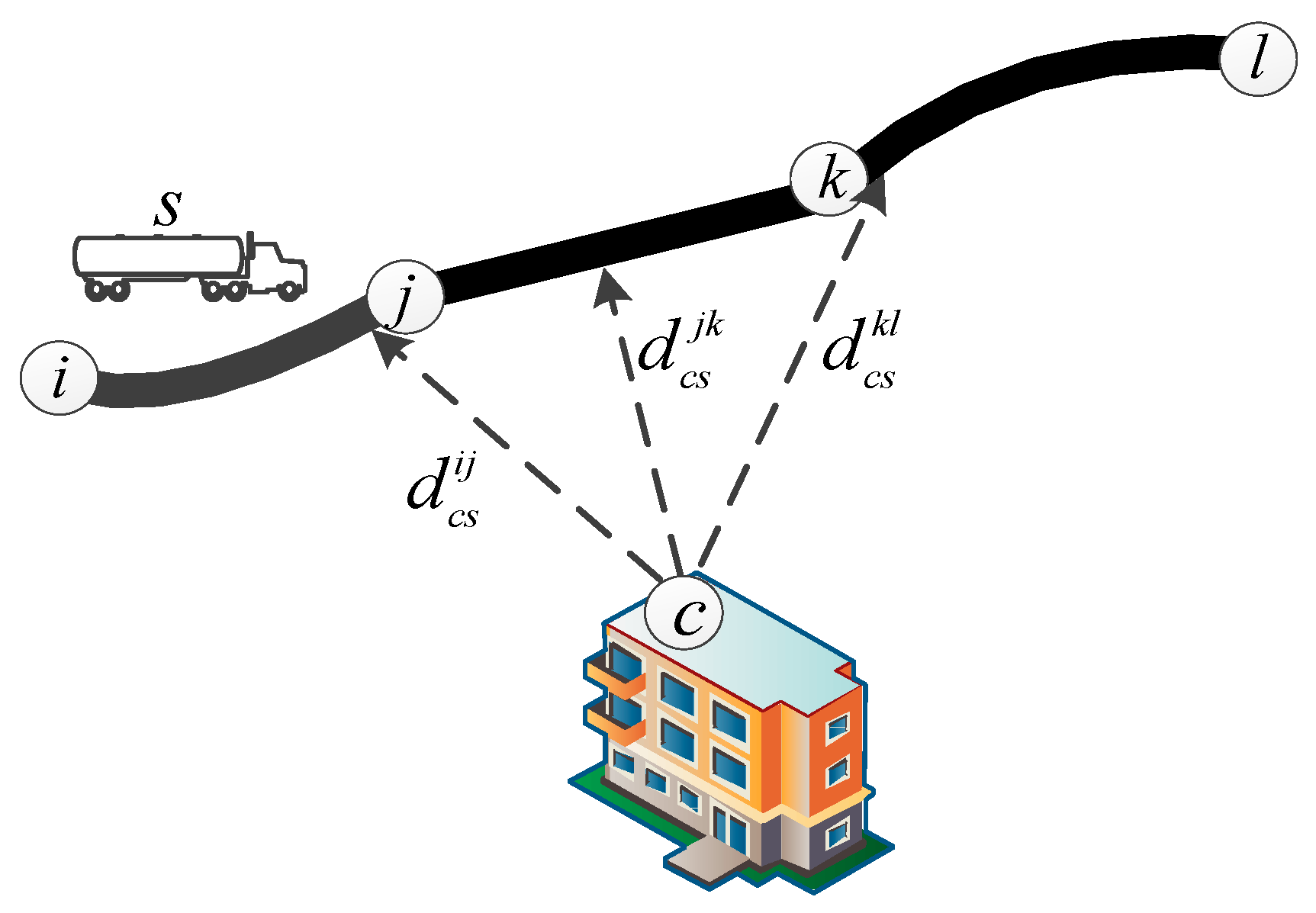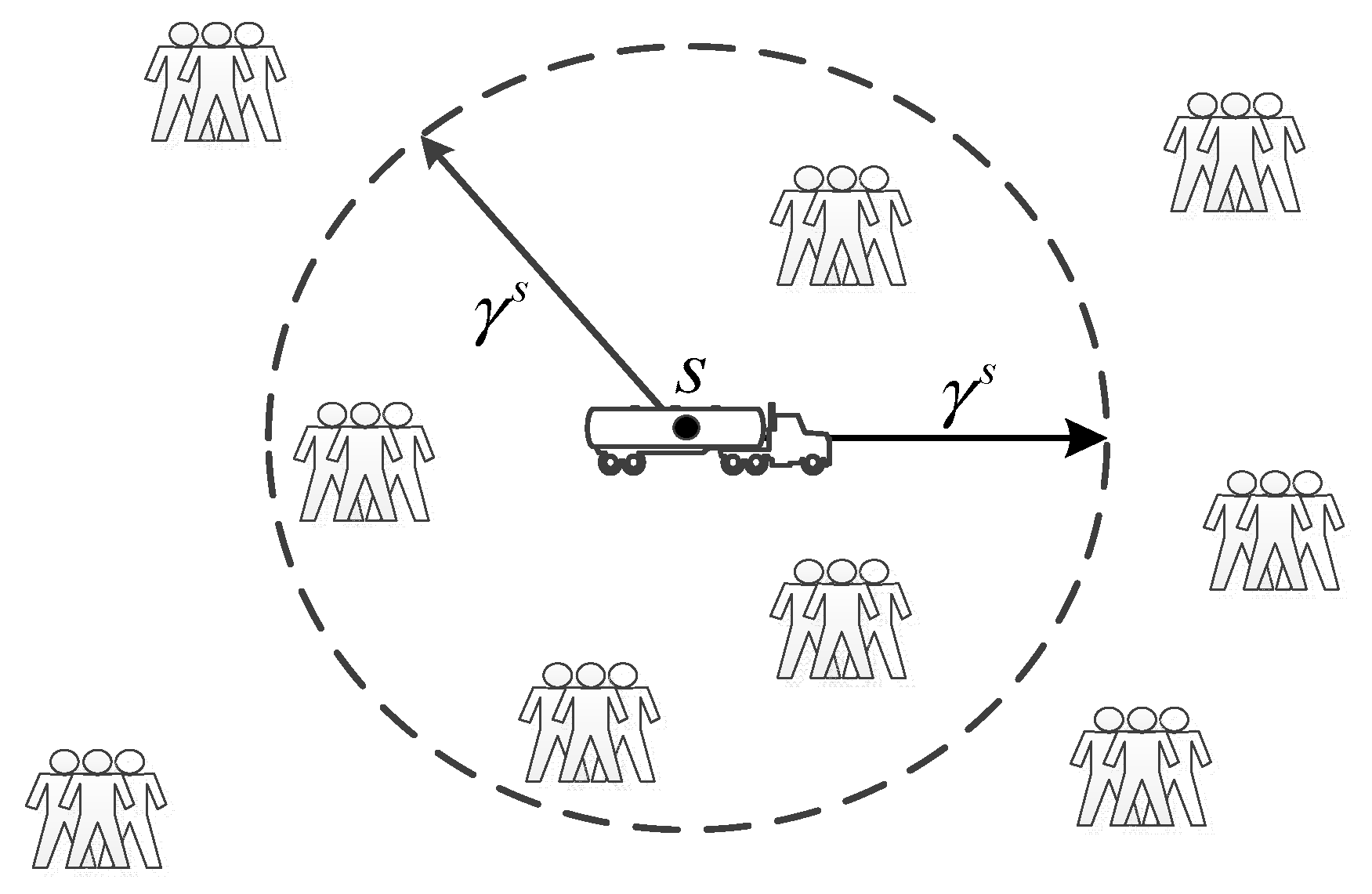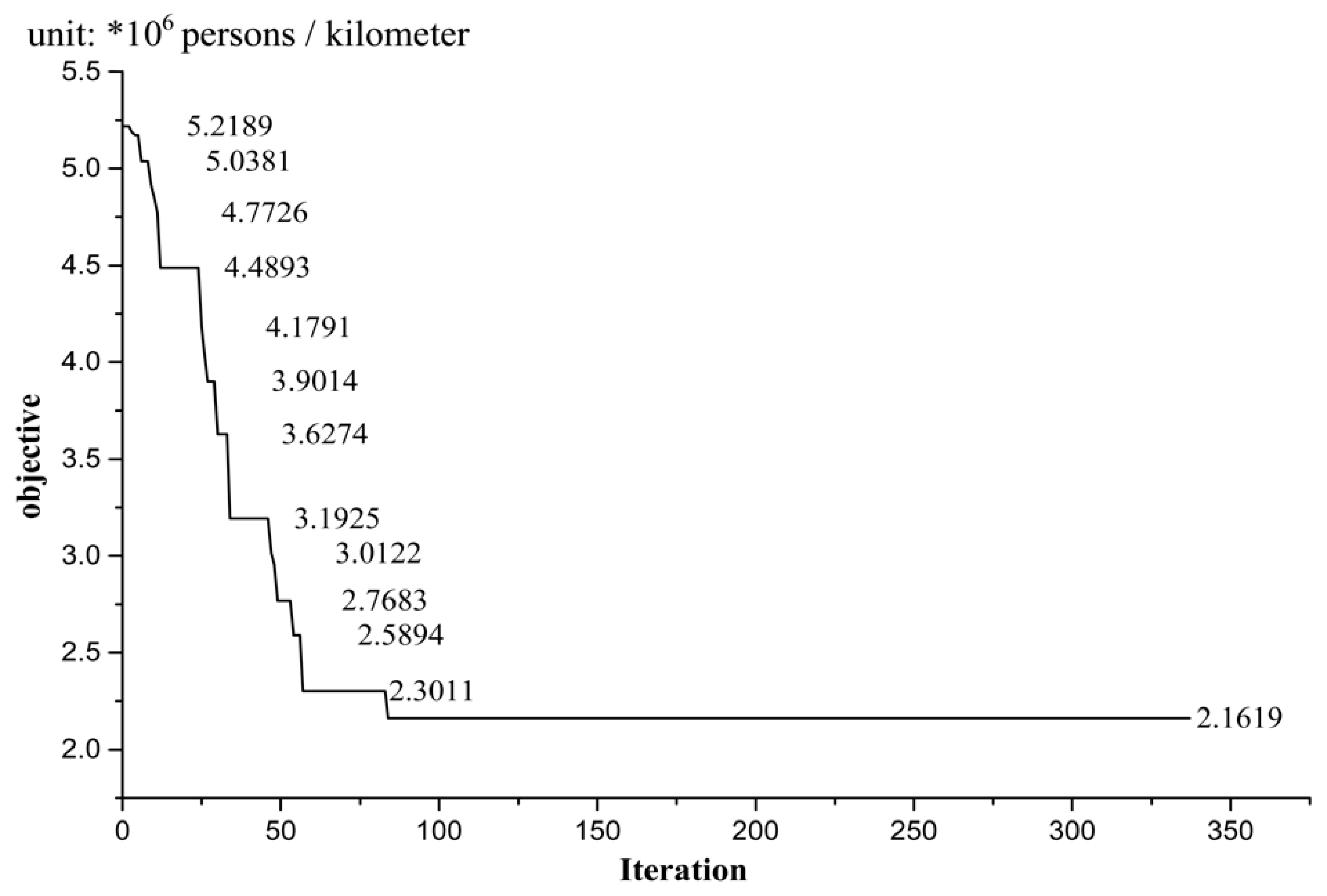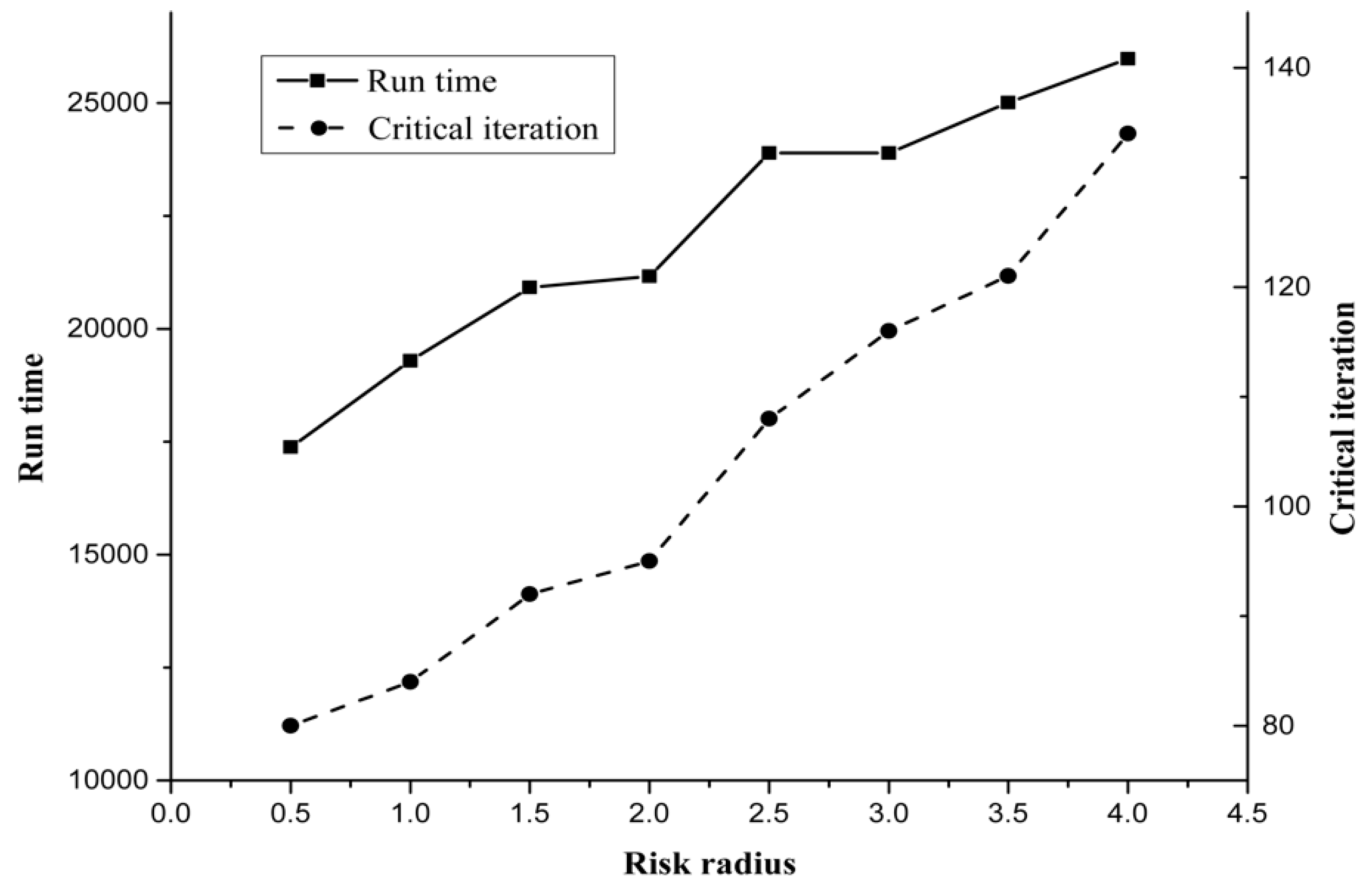Routing for Hazardous Materials Transportation in Urban Areas
Abstract
1. Introduction
2. An Optimization Model
2.1. Problem Hypotheses
2.2. Model Establishment
- :
- Set of HAZMAT shipments, indexed by , and the number of shipments is .
- :
- Auxiliary decision variable, maximum local risk caused by the closest link of shipment to population centers, unit: persons per kilometer.
- :
- Transportation demand of shipment , measured by the number of standardized vehicles;
- :
- Nodes of road transportation network in the urban area, and the number of nodes is ;
- :
- Set of links of road transportation network in the urban area, , and the number of links is ;
- :
- Set of population centers, indexed by ;
- :
- Population quantity of center , unit: persons, and the number of centers is ;
- :
- Euclidean distance between center and its closest point on link of shipment , illustrated in Figure 1, unit: kilometers;
- :
- Decision variable, which is equal to 1 if link used for HAZMAT shipment is the closest link to , 0 otherwise.
- :
- Decision variable, which is equal to 1 if link is used for HAZMAT shipment , 0 otherwise.
- :
- This notation has been explained in Formula (2).
- :
- Referring to the definition of ;
- :
- Referring to the definition of .
- :
- Origin of HAZMAT shipment ;
- :
- Destination of HAZMAT shipment .
- :
- Nonnegative constraint for auxiliary decision.
- :
- Constrained to be binary.
- :
- Constrained to be binary.
3. Algorithm Design
- Step 1:
- Initialization. List the structure of the transportation network including nodes and links, OD pairs for HAZMAT shipments and population centers in the area.
- Step 1-1:
- Set the counter , and determine the risk radius according to the type of HAZMAT for all shipments.
- Step 1-2:
- , compute the local risk along the route of shipment as . While , , set .
- Step 1-3:
- For all in the HAZMAT transportation network, compute the maximum local risk along the route of shipment as .
- Step 2:
- Initial Route. For all , the Dijkstra algorithm is used to search for a shortest route between and [23], and the route is denoted as for shipment . Thereafter, the maximum local risk to population centers along route is calculated as .
- Step 2-1:
- If , is an optimal solution route for shipment , and . The computation for shipment stops, turn to next shipment until all shipments are checked.
- Step 2-2:
- If , there is possible to search for a better route. For the corresponding turn to Step 3 for computation.
- Step 3:
- Route update. The initial route is improved by the following sub-steps.
- Step 3-1:
- , the set of links is obtained as . When , . Denote as the set of relevant nodes, and the candidate graph in iteration for shipment is . Thereafter, the counter .
- Step 3-2:
- , search for a feasible route over between and .
- Step 3-2-1:
- If no feasible route is found, the candidate graph in iteration for shipment is disconnected, is an optimal solution route for shipment , and . The computation for shipment stops, turn to next shipment until all shipments are checked.
- Step 3-2-2:
- If a feasible route is found, turn to Step 3-1.
- Step 4:
- Scheme check. In the completely connected transportation network, any shipment is able to be assigned an optimal route, and all optimal routes are the final output.
4. Case Study
5. Conclusions
Author Contributions
Funding
Conflicts of Interest
References
- Taslimi, M.; Batta, R.; Kwon, C. A comprehensive modeling framework for hazmat network design, hazmat response team location, and equity of risk. Comput. Oper. Res. 2017, 79, 119–130. [Google Scholar] [CrossRef]
- Kara, B.Y.; Verter, V. Designing a road network for hazardous materials transportation. Transp. Sci. 2004, 38, 188–196. [Google Scholar] [CrossRef]
- Erkut, E.; Alp, O. Designing a road network for hazardous materials shipments. Comput. Oper. Res. 2007, 34, 1389–1405. [Google Scholar] [CrossRef]
- Erkut, E.; Gzara, F. Solving the HAZMAT transportation network design problem. Comput. Oper. Res. 2008, 35, 2234–2247. [Google Scholar] [CrossRef]
- Verter, V.; Kara, B.Y. A path-based approach for hazmat transport network design. Manag. Sci. 2008, 54, 29–40. [Google Scholar] [CrossRef]
- Bianco, L.; Caramia, M.; Giordani, S. A bi-level flow model for HAZMAT transportation network design. Transp. Res. Part C Emerg. Technol. 2009, 17, 175–196. [Google Scholar] [CrossRef]
- Xie, Y.; Lu, W.; Wang, W.; Quadrifoglio, L. A multimodal location and routing model for hazardous materials transportation. J. Hazard. Mater. 2012, 227, 135–141. [Google Scholar] [CrossRef]
- Bianco, L.; Caramia, M.; Giordani, S.; Piccialli, V. A game-theoretic approach for regulating hazmat transportation. Transp. Sci. 2016, 50, 424–438. [Google Scholar] [CrossRef]
- Fan, T.; Chiang, W.C.; Russell, R. Modeling urban hazmat transportation with road closure consideration. Transp. Res. Part D Transp. Environ. 2015, 35, 104–115. [Google Scholar] [CrossRef]
- Bronfman, A.; Marianov, V.; Paredes-Belmar, G.; Lüer-Villagra, A. The maximin HAZMAT routing problem. Eur. J. Oper. Res. 2015, 241, 15–27. [Google Scholar] [CrossRef]
- Brotcorne, L.; Labbe, M.; Marcotte, P.; Savard, G. Joint design and pricing on a network. Oper. Res. 2008, 56, 1104–1115. [Google Scholar] [CrossRef]
- Marcotte, P.; Mercier, A.; Savard, G.; Verter, V. Toll Policies for Mitigating Hazardous Materials Transport Risk. Transp. Sci. 2009, 43, 228–243. [Google Scholar] [CrossRef]
- Li, T.; Sun, H.; Wu, J.; Ge, Y. Optimal toll of new highway in the equilibrium framework of heterogeneous households’ residential location choice. Transp. Res. Part A Policy Pract. 2017, 105, 123–137. [Google Scholar] [CrossRef]
- Bevrani, B.; Burdett, R.L.; Bhaskar, A.; Yarlagadda, P.K.D.V. A capacity assessment approach for multi-modal transportation systems. Eur. J. Oper. Res. 2017, 263, 864–878. [Google Scholar] [CrossRef]
- Bevrani, B.; Burdett, R.L.; Bhaskar, A.; Yarlagadda, P.K.D.V. A multi commodity flow model incorporating flow reduction functions. Flex. Serv. Manuf. J. 2019, in press. [Google Scholar] [CrossRef]
- Mohammadi, M.; Jula, P.; Tavakkoli-Moghaddam, R. Design of a reliable multi-modal multi-commodity model for hazardous materials transportation under uncertainty. Eur. J. Oper. Res. 2017, 257, 792–809. [Google Scholar] [CrossRef]
- Hosseini, S.D.; Verma, M. A Value-at-Risk (VAR) approach to routing rail hazmat shipments. Transp. Res. Part D Transp. Environ. 2017, 54, 191–211. [Google Scholar] [CrossRef]
- Fontaine, P.; Minner, S. Benders decomposition for the Hazmat Transport Network Design Problem. Eur. J. Oper. Res. 2018, 267, 996–1002. [Google Scholar] [CrossRef]
- Fazayeli, S.; Eydi, A.; Kamalabadi, I.N. Location-routing problem in multimodal transportation network with time windows and fuzzy demands: Presenting a two-part genetic algorithm. Comput. Ind. Eng. 2018, 119, 233–246. [Google Scholar] [CrossRef]
- Ghaderi, A.; Burdett, R.L. An integrated location and routing approach for transporting hazardous materials in a bi-modal transportation network. Transp. Res. Part E Logist. Transp. Rev. 2019, 127, 49–65. [Google Scholar] [CrossRef]
- Jabbarzadeh, A.; Azad, N.; Verma, M. An optimization approach to planning rail hazmat shipments in the presence of random disruptions. Omega 2019. [Google Scholar] [CrossRef]
- Hu, H.; Li, X.; Zhang, Y.; Shang, C.; Zhang, S. Multi-objective location-routing model for hazardous material logistics with traffic restriction constraint in inter-city roads. Comput. Ind. Eng. 2019, 128, 861–876. [Google Scholar] [CrossRef]
- Zhang, W.; Jiang, C. Optimization studies on an improved Dijkstra algorithm. In Proceedings of the 3rd International Conference on Information Technology and Science Management (ICITST 2011), Abu Dabi, UAE, 11–14 December 2011; pp. 2918–2921. [Google Scholar]
- Feng, X.; Zhu, X.; Qian, X.; Jie, Y.; Ma, F.; Niu, X. A new transit network design study in consideration of transfer time composition. Transp. Res. Part D Transp. Environ. 2019, 66, 85–94. [Google Scholar] [CrossRef]





| Center | C1 | C2 | C3 | C4 | C5 | C6 | C7 | C8 |
| Population | 4270 | 4910 | 5180 | 7100 | 6850 | 5190 | 6230 | 10020 |
| Center | C9 | C10 | C11 | C12 | C13 | C14 | C15 | C16 |
| Population | 9470 | 5960 | 8030 | 12030 | 7310 | 7210 | 5540 | 14640 |
| Shipment | S1 | S2 | S3 | S4 | S5 | S6 |
| OD pair | N1-N226 | N2-N305 | N3-N271 | N4-N225 | N5-N193 | N6-N236 |
| Demand | 10 | 15 | 20 | 25 | 10 | 15 |
| Shipment | S7 | S8 | S9 | S10 | S11 | S12 |
| OD pair | N7-N164 | N8-N322 | N9-N150 | N10-N297 | N11-N148 | N12-N249 |
| Demand | 20 | 25 | 10 | 15 | 20 | 25 |
| Index | Shipment Set | Deterministic Solving by CPLEX 12.8 | The Proposed Heuristic Algorithm | Gap |
|---|---|---|---|---|
| Optimal objective (persons/km) | S1–S4 | 0.6335 × 106 | 0.7156 × 106 | 12.97% |
| S1–S8 | 1.3371 × 106 | 1.5075 × 106 | 12.74% | |
| S1–S12 | 1,9268 × 106 | 2.1619 × 106 | 12.20% | |
| Max Rs (persons/km) | S1–S4 | 2.5083 × 105 | 2.6241 × 105 | 4.62% |
| S1–S8 | 2.5083 × 105 | 2.6241 × 105 | 4.62% | |
| S1–S12 | 2.7358 × 105 | 2.7358 × 105 | 0.00% | |
| Run time (s) | S1–S4 | 1.8729 × 104 | 0.8461 × 104 | 121.36% |
| S1–S8 | 3.6114 × 104 | 1.3715 × 104 | 163.32% | |
| S1–S12 | 5.3782 × 104 | 1.9295 × 104 | 178.73% |
| Risk Radius (km) | Optimal Objective (persons/km) | Max Rs (persons/km) |
|---|---|---|
| 0.5 | 2.2348 × 106 | 3.0155 × 105 |
| 1.0 | 2.1619 × 106 | 2.7358 × 105 |
| 1.5 | 2.0862 × 106 | 2.5183 × 105 |
| 2.0 | 2.0047 × 106 | 2.4924 × 105 |
| 2.5 | 1.9490 × 106 | 2.4418 × 105 |
| 3.0 | 1.9205 × 106 | 2.3561 × 105 |
| 3.5 | 1.9205 × 106 | 2.3561 × 105 |
| 4.0 | 1.9205 × 106 | 2.3561 × 105 |
© 2019 by the authors. Licensee MDPI, Basel, Switzerland. This article is an open access article distributed under the terms and conditions of the Creative Commons Attribution (CC BY) license (http://creativecommons.org/licenses/by/4.0/).
Share and Cite
Zhang, L.; Feng, X.; Yang, Y.; Ding, C. Routing for Hazardous Materials Transportation in Urban Areas. Symmetry 2019, 11, 1091. https://doi.org/10.3390/sym11091091
Zhang L, Feng X, Yang Y, Ding C. Routing for Hazardous Materials Transportation in Urban Areas. Symmetry. 2019; 11(9):1091. https://doi.org/10.3390/sym11091091
Chicago/Turabian StyleZhang, Lukai, Xuesong Feng, Yan Yang, and Chuanchen Ding. 2019. "Routing for Hazardous Materials Transportation in Urban Areas" Symmetry 11, no. 9: 1091. https://doi.org/10.3390/sym11091091
APA StyleZhang, L., Feng, X., Yang, Y., & Ding, C. (2019). Routing for Hazardous Materials Transportation in Urban Areas. Symmetry, 11(9), 1091. https://doi.org/10.3390/sym11091091




